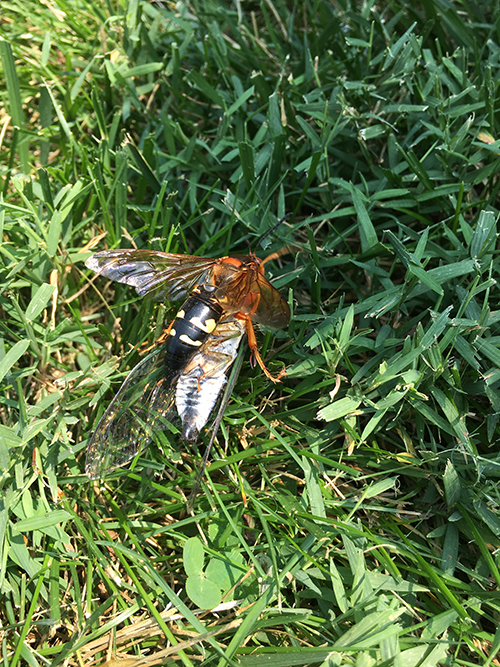
MIKE MILLER
All of this insect activity also brings out those things that use insects as a food source. Birds are obvious benefactors, consuming insects as a food for themselves and their young. What might not be so obvious is the fact that there are several types of insects that eat other insects. Wasps are one example. There are several types of wasps. Some are social insects (paper wasps, yellow jackets, and hornets) that build large colonies. Others are solitary wasps that live out their lives without depending on a hive mentality. The diversity of wasps is incredible and their life stories are as fascinating.
In the last couple of years, the media has been abuzz with stories of “Murder Hornets” that have made a limited appearance in the Pacific Northwest. These are large-sized, social wasps that like to feed on honey bee colonies. Both honey bees and so-called “murder hornets” are not native to North America, but seem to get a lot of attention. Not every huge wasp is a murder hornet. There are several large wasps that call Illinois their home. One species becomes obvious to anyone who spends time outside in August … The Cicada Killer.
This is a big, formidable-looking wasp. Unlike the so-called murder hornet, that is a social insect who builds a large colony, the Cicada Killer is a solitary wasp. It lives its life without building a huge colony. Male Cicada Killers will set up a territory which they will patrol and try and keep other males from jumping their claim. These males can be outright belligerent. They might fly right at you, hover in front of your face, and even bump into you. However, it is all for show. Male wasps cannot sting. Their empty threats are all designed to claim a bit of earth for the female to do her thing.
The female Cicada Killer is the one that does all of the work. In a territory guarded by a male, she digs a tunnel in loose, light soil. This tunnel is about an inch in diameter and can go several inches into the soil. Within this tunnel, she builds several, short side tunnels. It is within these side tunnels that she will carry out an amazing part of her species’ life cycle.
Unlike her male counterpart, she can sting. However, this sting is seldom used on people. You would actually have to pick her up and handle her to receive a sting. She has a much more important use for this ability. She will fly amongst the tree-tops on warm summer days. She is looking for an insect that is as big as she is and is singing a whirring, buzzy call … The annual cicada. The female wasps hunt by sight, and usually seek out female cicadas, which don’t produce sound. Once spotted, the wasp will usually capture the cicada in flight and sting it. Her goal is not to kill it, but to render it paralyzed. Once her venom has subdued the cicada, she carries the large payload back toward her tunnel. It is a real aerodynamic feat since the cicada is larger than the wasp, but somehow it works. Once she gets back to her tunnel, she stuffs the paralyzed cicada into one of the side tunnels and lays a single egg within the still-living insect. She will seal off the side tunnel, and go off to find more cicadas. Her life will soon be over, once her tunnel is full and her eggs are laid.
The larvae will hatch within the paralyzed cicada in a few days. They will feed on the cicada, from the inside out. Within a couple of weeks, the larvae will have grown and builds a pupa from silk and soil, and suspend itself within the tunnel. They will over-winter underground, and emerge the following summer and start the whole process anew. A new generation of males to defend territory, and females to seek out cicadas.
The dog days of summer are filled with numerous hidden dramas such as this. The varieties of hidden stories are as diverse as the species of life that inhabits this planet. Each insect buzz, whirr and click speaks volumes about the lifecycle lurking beneath the surface. It certainly gives us something to ponder as we sit on the porch and listen to the evening insect chorus unfold.

